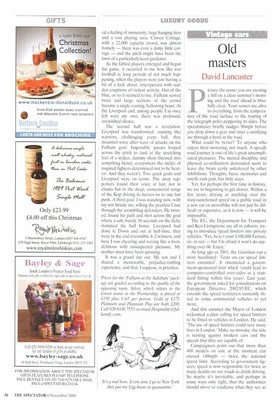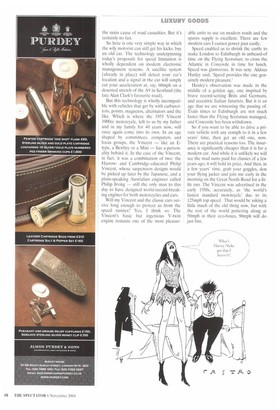Vinta e cars
Old masters
David Lancaster
picture the scene: you are cresting a hill on a clear summer's morning and the road ahead is blissfully clear. Your senses arc alive to everything, from the temperature of the road surface to the routing of the telegraph poles peppering its sides. The speedometer briefly nudges 90mph before you drop down a gear and steer a satisfying arc through a bend in the road.
What could be better? To anyone who enjoys their motoring, not much. A speedy road journey is one of life's great uncomplicated pleasures. The mental discipline and physical co-ordination demanded seem to leave the brain eerily unfettered by other inhibitions. Thoughts, faces, memories and smells rush past, but little stays.
Yet, for perhaps the first time in history, we are to beginning to get slower. Within a few years, driving at anything over the state-sanctioned speed on a public road in a new car or motorbike will not just be difficult or expensive, as it is now — it will be impossible.
The EU, the Department for Transport and Ken Livingstone are all in cahoots, trying to introduce speed limiters into private vehicles. 'Yes, here's your £100,000 Ferrari, sir, in red — but I'm afraid it won't do anything over 60. Enjoy.'
As long ago as 2001, the Guardian ran a story headlined: 'Tests on car speed limiters extended'. It chronicled a government-sponsored trial which 'could lead to computer-controlled over-rides as a standard fitting within five years'. Last year, the government asked for consultations on European Directive 2002/85/EC, which extends the speed restricters currently fitted to some commercial vehicles to yet more.
And this summer the Mayor of London welcomed a plan calling for speed limiters to be fitted to vehicles in London. He said, 'The use of speed limiters could save many lives in London.' Make no mistake, the tide is turning against modern cars and the speeds that they are capable of.
Campaigners point out that more than 400 models on sale at the moment can exceed 140mph — twice the national speed limit. According to government figures, speed is now responsible for twice as many deaths on our roads as drink-driving. So maybe it's inevitable, and perhaps in some ways only right, that the authorities should move to eradicate what they see as the main cause of road casualties. But it's certainly no fun.
So here is one very simple way in which the wily motorist can still get his kicks: buy an old car. The technology underpinning today's proposals for speed limitation is wholly dependent on modern electronic management systems. A satellite system (already in place) will detect your car's location and a signal in the car will simply cut your acceleration at, say, 60mph on a deserted stretch of the A9 in Scotland (the late Alan Clark's favourite road).
But this technology is wholly incompatible with vehicles that get by with carburettors, points, magnetos, alternators and the like. Which is where the 1955 Vincent 1000cc motorcycle, left to us by my father and in my family for 40 years now, will once again come into its own. In an age shaped by committees, computers and focus groups, the Vincent — like an Etype, a Bentley or a Mini — has a personality behind it. In the case of the Vincent, in fact, it was a combination of two: the Harrowand Cambridge-educated Philip Vincent, whose suspension designs would he picked up later by the Japanese, and a plain-speaking Australian engineer called Philip Irving — still the only man to this day to have designed world-record-breaking engines for both motorcycles and cars.
Will my Vincent and the classic cars survive long enough to protect us from the speed nannys? Yes, I think so. The Vincent's basic but ingenious V-twin engine remains one of the most pleasur
able units to use on modern roads and the spares supply is excellent. There are few modern cars I cannot power past easily.
Speed enabled us to shrink the earth; to make London to Edinburgh in unheard-of time on the Flying Scotsman; to cross the Atlantic in Concorde in time for lunch. Speed was glamorous. It was sexy. Aldous Huxley said, 'Speed provides the one genuinely modern pleasure.'
Huxley's observation was made in the middle of a golden age, one inspired by brave record-setting Brits and Germans, and eccentric Italian futurists. But it is an age that we are witnessing the passing of. Train times to Edinburgh are not much faster than the Flying Scotsman managed, and Concorde has been withdrawn.
So if you want to be able to drive a private vehicle with any oomph to it in a few years' time, then get an old one, now. There are practical reasons too. The insurance is significantly cheaper than it is for a modern car. And while it is unlikely we will see the mad sums paid for classics of a few years ago, it will hold its price. And then, in a few years' time, grab your goggles, don your flying jacket and join me early in the morning on the Great North Road for a little run. The Vincent was advertised in the early 1950s, accurately, as 'the world's fastest standard motorcycle' due to its 125mph top speed. That would be asking a little much of the old thing now, but with the rest of the world pottering along at 50mph in their eco-boxes, 90mph will do just fine.



























































































































 Previous page
Previous page